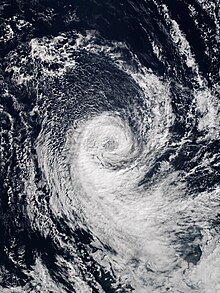Subtropical Cyclone Katie
 The storm near peak intensity, on 2 May | |
| Meteorological history | |
|---|---|
| Formed | 29 April 2015 |
| Remnant low | 4 May 2015 |
| Dissipated | 6 May 2015 |
| Subtropical cyclone | |
| 1-minute sustained | |
| Highest winds | 75 km/h (45 mph) |
| Lowest pressure | 993 hPa (mbar); 29.32 inHg |
| Overall effects | |
| Fatalities | None |
| Damage | None |
| Areas affected | Easter Island |
Part of the 2014–15 South Pacific cyclone season (unofficially) | |
Subtropical Cyclone Katie, unofficially named by researchers, was an unusual weather event in early 2015. After the
Meteorological history

Tropical storm (39–73 mph, 63–118 km/h)
Category 1 (74–95 mph, 119–153 km/h)
Category 2 (96–110 mph, 154–177 km/h)
Category 3 (111–129 mph, 178–208 km/h)
Category 4 (130–156 mph, 209–251 km/h)
Category 5 (≥157 mph, ≥252 km/h)
Unknown
On 29 April 2015, near the end of the
Records
Subtropical Cyclone Katie is unofficially the third-easternmost tropical or subtropical cyclone ever observed to form in the South Pacific Ocean, transitioning into a subtropical system near 102.9°W.
Notes
- ^ All wind speeds in the article are maximum sustained winds sustained for one minute, unless otherwise noted.
See also
- Other storms of the same name
- Subtropical Cyclone Lexi
- Subtropical Cyclone Humberto
- 2006 Central Pacific cyclone
- Subtropical Storm 96C
- Hurricane Catarina
- Tropical Storm Rolf
- Cyclone Qendresa
- Cyclone Numa
- Cyclone Ianos
- 1996 Lake Huron cyclone
- Mediterranean tropical-like cyclone
- South Atlantic tropical cyclone
- 1982–83 South Pacific cyclone season – Saw a tropical depression developing east of 120°W
- 2017–18 South Pacific cyclone season
- Tropical cyclogenesis
- El Niño–Southern Oscillation
References
- ^ a b c d e f Diamond, Howard J (25 August 2015). "Review of the 2014/15 Tropical Cyclone Season in the Southwest Pacific Ocean Basin". Climate Program Office. National Oceanic and Atmospheric Administration. Retrieved 16 October 2017.
- ^ a b c RA V Tropical Cyclone Committee (12 November 2012). Tropical Cyclone Operational Plan for the South-East Indian Ocean and the Southern Pacific Ocean 2012 (PDF) (Report No. TCP-24). World Meteorological Organization. pp. 15–20. Archived (PDF) from the original on 3 March 2016. Retrieved 29 March 2015.
- ^ hdl:1874/353366.
- ^ a b c d e f g Steve Young (27 July 2015). "Monthly Global Tropical Cyclone Tracks April 2015". Australia Severe Weather. Retrieved 16 October 2017.
- ^ a b Pacific ENSO Update — Quarter 1, 1998. Pacific ENSO Update (Report). Vol. 4. The Pacific ENSO Applications Climate Centre. Archived from the original on 4 March 2016.
- ^ Levi Cowan (7 May 2018). "Subtropical Cyclone". Twitter. Retrieved 10 May 2018.
- ^ a b John Leslie (9 May 2018). "Rare Subtropical Storm off the Coast of Chile". NOAA. Retrieved 10 May 2018.
- ^ Jonathan Belles (9 May 2018). "Extremely Rare Southeast Pacific Subtropical Cyclone Forms Off the Chilean Coast". weather.com. The Weather Company. Retrieved 25 June 2019.
- ^ Marshall Shepherd (10 May 2018). "Subtropical Cyclones Don't Normally Form Near Chile - But One Just Did". Forbes. Retrieved 22 February 2021.
- ^ Rochabrun, Marcelo (14 March 2023). "Peru's Desert Coast Braces for More Deadly Rains From Cyclone". Bloomberg. Bloomberg News. Retrieved 20 April 2023.

